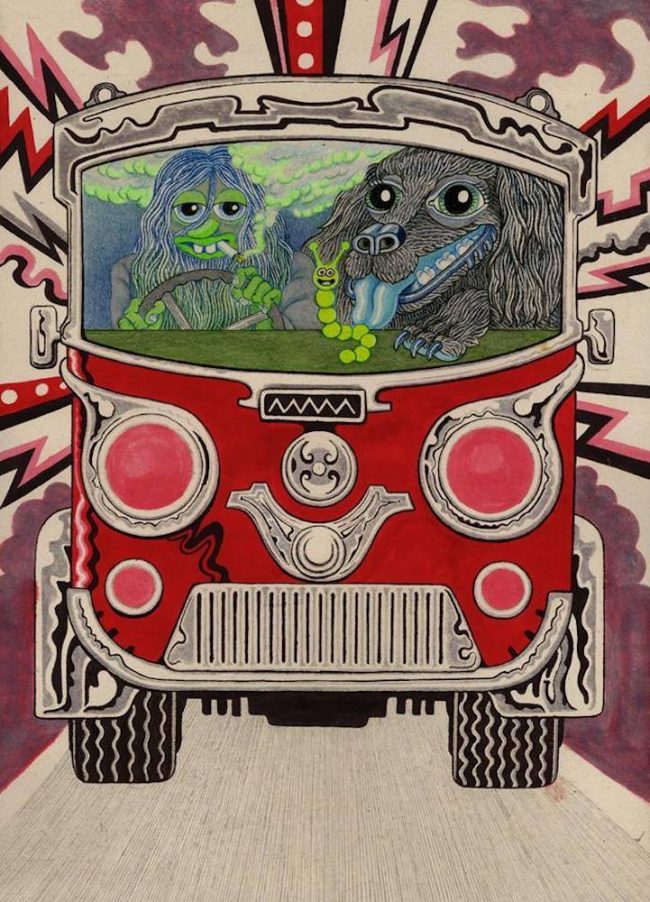Your progress through Grok, a retrospective collection of illustrations and commercial art by Will Sweeney, arrives eventually at the book's last double-page spread, a 2014 black & white drawing titled Arachnoid Moon; and the gang's all here. Cataloging its crowd scene would take a week, but at the focus a female figure either performing or revered—goddess, guru or Gaga—emerges from a float shaped like a skull before a thrilled crowd of citizens wearing spiked helmets modeled on horse-chestnut shells, while her rhythm section of priests rocks out behind her. Masked and robed officials watch from the more expensive seats on nearby ziggurats, while truckloads of squirming organic matter arrive for the concession stands. But those adoring fans are being herded along by guards waving Kirby-tech weapons while exposed to some kind of amorphous ectoplasm, the arena's master of ceremonies has a string of severed heads hanging from his belt to match the one on Lady Gaga's float, and a shady character in long coat and fedora is taking pictures of the crowd, keeping tabs on things for some Ministry of Joy. Everything is busy in the busiest of all possible worlds, a functioning class system of serfs and slavers, elites and proles, raving under the shadow of death.
Versions of this cast of eccentrics crop up throughout the book in different forms and combinations, underlining Sweeney's areas of interest as well as the consistent intensity of his technique. You don't have to peer at all to see more of the politics, class friction and violence when it appears in Workforce, where a different stream of citizens, laborers in this case, is glumly marshaled by more armed guards onto the up-escalator for another day of mirthless toil somewhere on an upper floor—no down-escalator appears necessary. Colonial Scene has a pair of armored alien conquistadors surveying their acquired lands while one of them blithely pisses into a river. Billionaire Space Vampire shows a humanoid on a medical couch being attended by a robotic figure, although which of them is the vampire might be debatable. And Mustard Gas 2, a title bringing its own wartime meaning, is a tortured illustration of pendulous crimson forms descending down a rancid yellow background like drops of coagulating blood.

Then there's the life of the mind. Grok has a steady stream of seekers, some of them wandering in the wrong direction. The figure in Hotel Relaxo is lying inside a large bisected prop head as if it was an MRI scanner designed by Mattel, and instructed to RELAX in ear-splitting capital letters. Truth and Goodness is a meditating figure in lotus position, fanciful metal machinery emerging from his face and groping upwards towards an eye of knowledge while his chakras throb, the mechanical in pursuit of the spiritual. And since seekers can also be twits, Flatearthers has a bunch of dingbats with their minds tightly shut and their heads enclosed in sealed boxes, amplifying their voices while closing off their senses. One of them is preaching a religious viewpoint, but his audience includes a gentleman who has inserted himself upside-down into the sand like a tent peg.

Not all the art in Grok is by Sweeney solo, and the collaborations look like a smooth merger of one artist's content within another artist's forms, a strict creative synergy rather than any wilder creative friction. Sweeney and London-based artist Susumu Mukai, whose own style is as centered on grey shadings and tones as Sweeney's is on firm lines and color, combine forces for two pencil drawings of turmoil, of landscapes in ruins and war machines overrun with fungoid debris, that look like revisions of Hieronymus Bosch. At the far, far opposite end of the spectrum, Matt Furie collaborates on The Doorz, a set of images apparently created in an open-ended relay operation between the artists, in which some of Furie's saucer-eyed laid-back characters navigate a colorful cosmos, the most blissed-out figures in the book. Certainly, the happiest.

There's no sign of Sweeney's sequential comics art in Grok, so nothing of Tales from Greenfuzz with its anthropomorphic vegetables, although the eating of bowlfuls of wormy edibles in restaurants and at dinner parties is another thread in the book's selection. But Sweeney's strongest comics influences are hard to miss. Charles Burns is clearly one; and Jack Kirby is a given. Several Kirby figures stride across Sweeney's landscapes, and the sprawling abstract composition Energy Cannot Be Destroyed is a swarm of Kirby Komponents furiously trying to assemble into something magnificent. Sweeney is repurposing Kirby here though, since the technological sublime—very much Kirby's bag, the pulse behind his celestial pity and terror—isn't really Sweeney's thing. The Kirby spirit Sweeney channels most looks like the late-1970s Lord of Light Kirby, Kirby the city planner, the social engineer. Burns's Black Hole teenagers and Kirby's space-gods are on the way to becoming something else; but even Sweeney's hedonists seem likely to be stuck where they are, and will be clocking in back at the factory again on Monday morning.

These laconic spectacles, all this organized congestion and state-sponsored trepidation, has plenty of Thanatos but not much Eros—perhaps not a bad vibe for a modern jobbing commercial artist, and Sweeney's style slots smoothly onto the record sleeves and paperback covers included here. These landscapes of ritual and symbols are great entertainment but the artist is an observer rather than a participant, and consequently so are you. Stuart Davis, the American painter who marshaled a few vibrant abstract color forms of his own in the 1940s as part of being vocally anti-fascist, said that a work of art should be impersonal in execution rather than a seismographic chart of the artist's nervous system; Sweeney's nervous system seems under control, even in his most chaotic churning mindscapes. The coolest head in Arachnoid Moon is that secret agent, calmly observing. Davis also wrote about seeing an artist as the cool spectator at an arena of hot events—and there he is.







